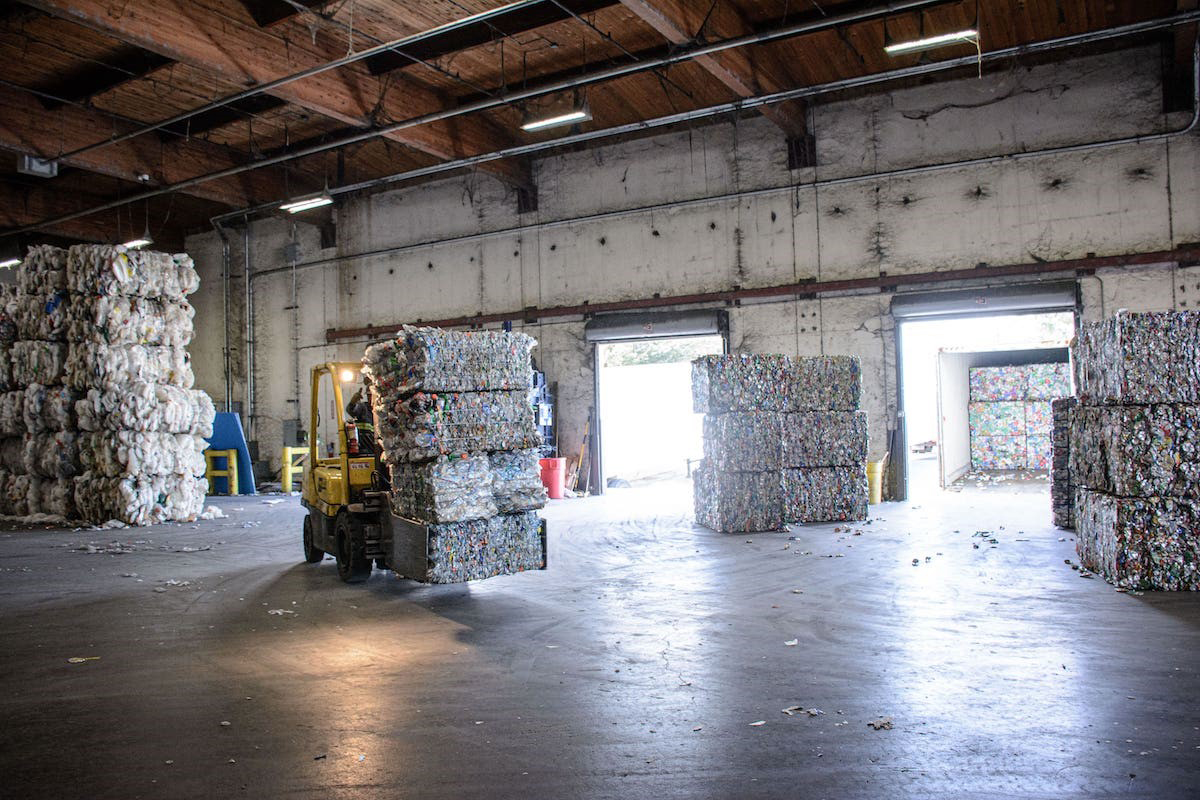Why plastic is building up at recycling centers and catching fire
Recycling plants are amassing millions of tons of plastic bottles, the Environmental Protection Agency says, with some becoming part of a growing problem of toxic fires at these plants, according to data provided by environmental advocates. Critics say beverage companies should be doing more to make their products more recyclable.
The majority of the combustible build-up at facilities is polyethylene terephthalate plastic, better known as PET, a clear, strong plastic typically used to make single-use beverage bottles, packaging, clothing and carpets. Most consumers believe this type of plastic can be recycled, but the majority of it is sitting in recycling facilities where experts say it is at risk of catching fire.

The problem of PET trash has been made worse because so much of it is not recycled. In the U.S., plastic bottles are sold to reprocessing plants where about 29% of them are recycled, according to the National Association for PET Container Resources. The rest end up in landfills, or often pile up until they can be sold and exported to other countries. Previously, the primary buyer for PET plastic was China, but it issued an import ban on plastic waste in early 2018.
Another reason PET bottles are building up is because so many are made with colorful dyes, most commonly green like in soda bottles, and use shrink-wrap labels, destroying the recyclability of the plastic, experts say.
"I've seen more fires in the last two years than I've ever seen," Ryan Fogelman, a fire suppression entrepreneur who tracks fires at recycling plants around the U.S., told ABC News. While the exact cause of the fires is unclear and can vary, experts say a buildup of plastics and other materials ignited by batteries may be to blame.
Steadily increasing number of fires
More than 82 million metric tons of PET plastic are produced globally every year, the U.S. Department of Energy's National Renewable Energy Laboratory says. This is over 30 times the amount of plastic in the Great Pacific Garbage Patch, which is currently about the size of Mexico.
Experts say the number of reported fires has steadily increased over the last five years and they believe this is due to a buildup of a combination of combustible materials like paper and plastic, sparks from discarded lithium-ion batteries and increasing temperatures as the climate warms.
Fogelman, who is part of a company that promotes fire prevention systems, began collecting data on waste and recycling facility fires in 2016 when he noticed a gap in data reporting on those type of fires. "There was absolutely no data anywhere," he told ABC News, "and if you look at the U.S. there's no regulation."
There were 343 fires reported at waste and recycling facilities in the United States and Canada in 2019, causing 49 injuries and two deaths, according to Fogelman's data, which was cited in an EPA report.
That figure increased to 367 fires in the U.S. and Canada in 2021, Fogelman reported, resulting in 37 injuries and two deaths.
Recent fires at recycling plants around the world have been reported in Turkey, South Wales and Austria as well as Northern California, New Mexico and the Bronx, where five firefighters were injured putting out a fire in June 2019, according to ABC affiliate WABC in New York.
Jan Dell, a chemical engineer, former White House national climate advisor and founder of watchdog nonprofit Last Beach Cleanup who tracks the fires, said she's noticed a lack of data reporting on recycling facility fires.
"I honestly can't keep up, there are so many of them," Dell told ABC News regarding the fires in recent years.
Plastic piling up
Jeff Donlevy, the general manager of Ming's Recycling facility in Haywood, California, said since the Chinese government banned plastic waste imports in 2018 these bottles have just been collecting in reprocessing facilities or sent to landfills. "Americans aren't converting this material to new bottles, that's not happening here," he said.

This is especially true with the green-dyed waste, according to Dell.
"In other countries, beverage companies are voluntarily switching to clear PET because they know it is actually recyclable," she said.
South Korea passed a series of regulations in 2020 prohibiting additive dyes or adhesive labels on plastic bottles to preserve the plastic's recyclability. Japan has held a similar practice since 2001, while France, the U.K. and other countries are following suit. The U.S. has not introduced a law in the national level, though local communities and companies are starting to take action.
In July, the Coca-Cola Company announced a phase-out of green-dyed PET Sprite bottles, among other soft drinks.
"Coca-Cola North America's entire green plastic portfolio—including packaging for Fresca, Seagram's and Mello Yello—will transition to clear PET in the coming months," the company said in a statement.
This follows the company's pledge in February to make 25% of its packaging reusable by the year 2030.

Kasey Lovett, senior director of communications for the American Beverage Association, touted the U.S. beverage industry's efforts to design recyclable bottles.
"America's beverage companies are always exploring innovative ways to create circularity for our bottles," Lovett said in a statement to ABC News.
But Judith Enck, a former EPA regional administrator and president of Beyond Plastics, said plastic bottles in the U.S. often aren’t recycled into new ones. Less than 10% of PET bottles are recycled into new food and beverage containers, according to the National Association for PET Container Resources' 2018 recycling activity report.
Enck says more often, PET plastics are recycled for one-time uses such as plastic decking or clothing. She also noted that green bottles are still in use for many popular soft drinks.
California recently passed a sweeping single-use plastic law which requires that 30% of plastic bought and sold in California be recyclable by 2028 and mandates a system of corporate accountability, the first law of its kind in the U.S.
State Sen. Ben Allen, who wrote the law and chairs the state's Committee on Environmental Quality, told ABC News, "Our whole idea is that we give the responsibility to the producers, the people who have the most skin in the game, to create more sustainable packaging."




